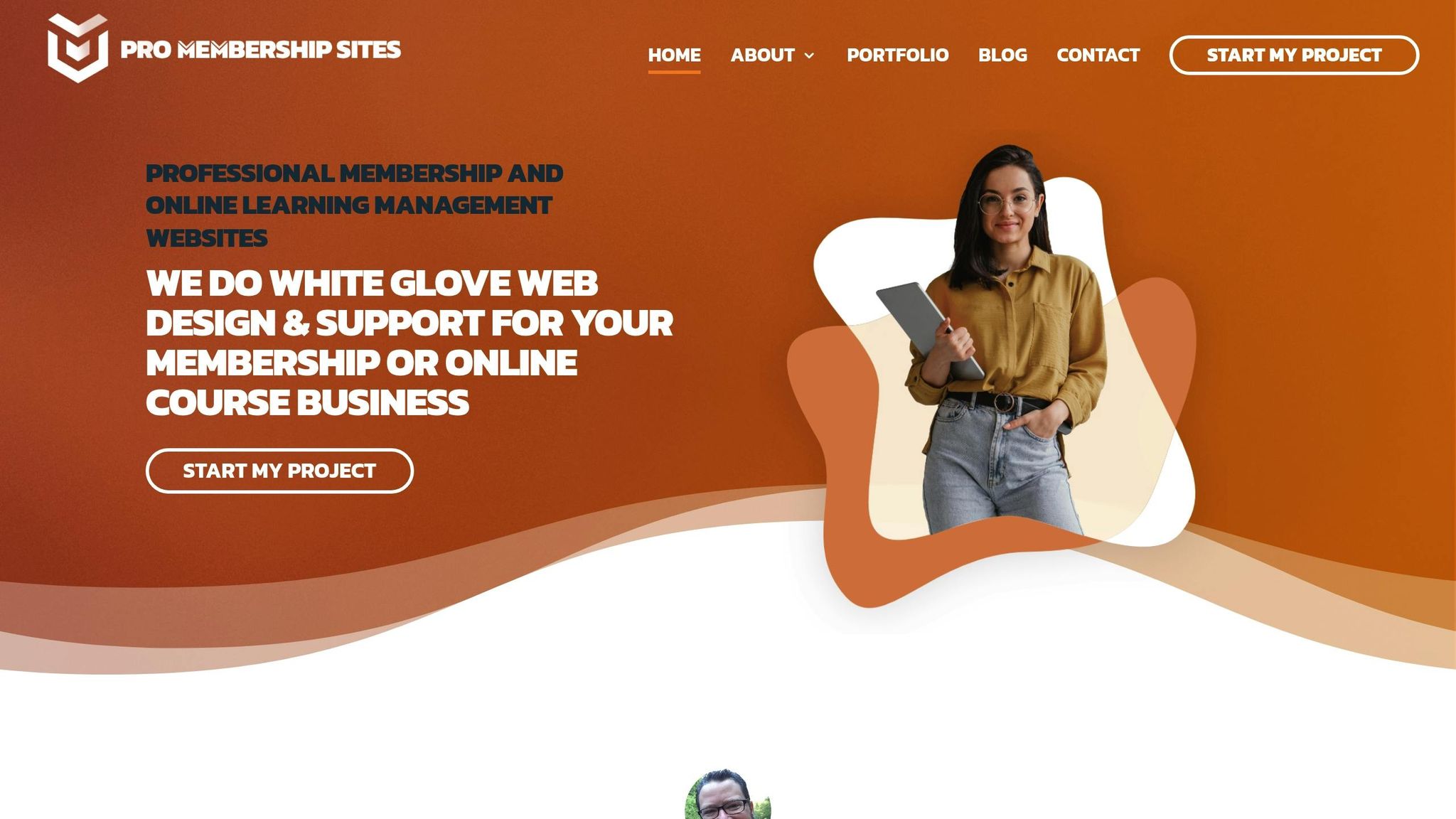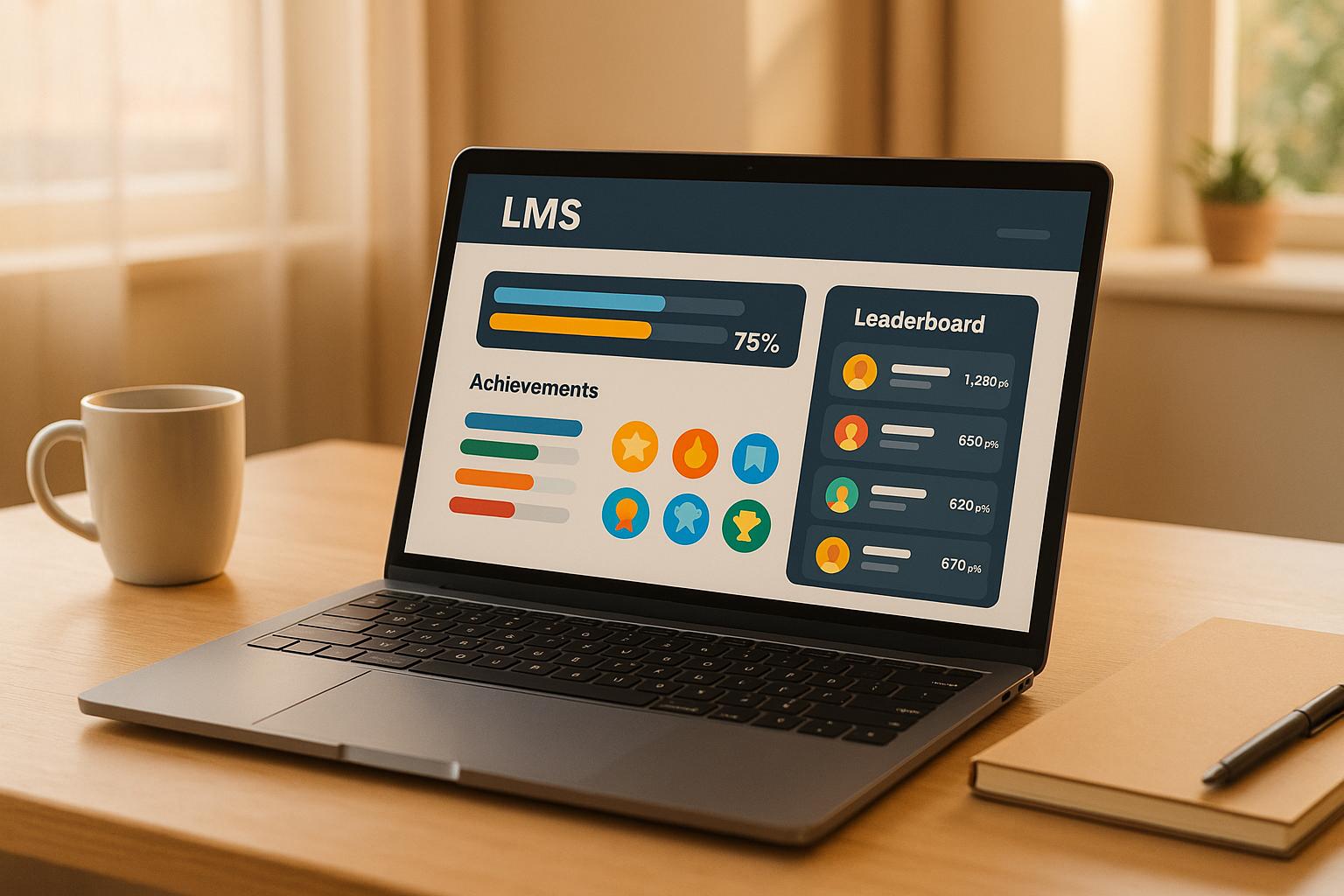Gamification in Learning Management Systems (LMS) makes learning more engaging and effective by integrating game-like elements into online education. Here’s what you need to know:
- Why Gamification Works
Gamification taps into our natural love for play and competition, boosting motivation, participation, and learning outcomes. For example, companies using gamified LMS tools report:- 60% higher engagement
- 34% better knowledge retention
- 50% increase in productivity
- 11% revenue growth per employee
- Key Features of Gamification
- Reward Systems: Points, badges, and leaderboards encourage participation and recognize achievements.
- Level Systems: Unlockable content and progressive challenges keep learners motivated.
- Interactive Tools: Quizzes, challenges, and instant feedback make learning active.
- Social Features: Peer recognition, group activities, and friendly competition foster collaboration and engagement.
- Real-World Examples
- How to Implement Gamification
- Set Clear Goals: Define measurable objectives for gamification.
- Design User-Centric Experiences: Tailor challenges and rewards to your audience.
- Track and Refine: Monitor metrics like engagement and completion rates to optimize results.
Gamification isn’t just a trend – it’s a proven way to improve learning outcomes and productivity in LMS platforms.
What is LMS Gamification? Ask John Leh – Talented Learning
Essential Gamification Features
Gamification features are a powerful way to boost engagement and productivity within Learning Management Systems (LMS). In fact, 89% of employees believe gamification could make them more productive at work.
Reward Systems
At the heart of gamification are points, badges, and leaderboards – key tools that encourage participation and recognize achievements. Here’s how they work:
| Feature | Purpose | Impact |
|---|---|---|
| Points | Track progress and participation | 89% of users report increased engagement when point systems are in place |
| Badges | Recognize achievements | Encourage higher completion rates and keep learners motivated |
| Leaderboards | Foster healthy competition | Inspire ongoing participation through friendly rivalry |
A great example of this is Cornerstone OnDemand’s 2014 rollout of badges and points, which significantly increased user engagement by tapping into social motivation. Beyond these, introducing structured level systems can deepen user involvement even further.
Level Systems
Level-based progression adds a sense of accomplishment and purpose by providing clear goals and unlockable content. Blackboard’s 2015 implementation is a standout example, featuring:
- Unlockable content tied to learner progress
- Advancement based on achievements
- Redeemable rewards through an internal company store
- Real-time progress tracking for immediate feedback
Learners overwhelmingly reported higher motivation levels thanks to these features.
Interactive Elements
Interactive features transform passive learning into active participation. Tools like quizzes, challenges, and instant feedback keep users engaged. Pearson, for instance, introduced missions where students earn virtual currency called "Yoops" to access academic services. Similarly, Canvas offers customizable gamification tools, enabling instructors to align interactive elements with specific learning goals.
With 61% of U.S. employees already experiencing gamified training at work, these features are no longer optional – they’re essential. By integrating reward systems, level-based progression, and interactive elements, LMS platforms can not only increase engagement but also improve learning outcomes, paving the way for more advanced gamification strategies.
Social Features in Gamification
Social features take gamification to the next level by making the experience more collaborative. They turn individual learning into a shared journey, which can significantly increase both engagement and retention. In fact, organizations that embrace social learning are 23% more likely to be industry leaders. Let’s dive into how elements like peer recognition, group activities, and competition contribute to better learning outcomes.
User Recognition
Acknowledging achievements is a powerful motivator. Peer recognition, in particular, can spark engagement and drive participation. For instance, IBM invested $300 million in social learning initiatives, leading to a 20–30% boost in both engagement and retention. It’s proof that a little recognition goes a long way in keeping users motivated.
Group Activities
Learning together creates a sense of community and strengthens retention. Adobe’s idea exchange program saw retention rates soar by 90%. Similarly, the University of Phoenix reported that 80% of students felt more engaged when working on group projects. Research backs this up – people retain nearly 70% more information when they learn collaboratively rather than alone.
"People retain information nearly 70% better when they learn from one another rather than in isolation."
Social Competition
When done thoughtfully, competition can energize users and enhance engagement. Features like team-based challenges, diverse leaderboards, and time-bound events create a healthy, safe sense of rivalry. Google’s Project Aristotle, for example, saw engagement jump by 53%. Balancing competitive elements can also lead to a 30% increase in overall engagement. LEGO’s Ideas platform is another success story – 10% of their new product launches now originate from user submissions.
sbb-itb-dee25d2
Gamification Implementation Guide
Strategic planning is the backbone of effective gamification. Research highlights a 47% boost in employee engagement for organizations that implement well-thought-out gamification strategies. Here’s how to design, measure, and customize gamified experiences for maximum impact.
Building Reward Systems
A solid reward system is essential for driving engagement. In fact, studies reveal that 89% of users are more engaged when a learning management system (LMS) incorporates a point system. To build an effective structure, focus on these elements:
- Clear Achievement Criteria: Clearly define the actions that earn points, badges, or other rewards.
- Progressive Challenges: Start with simpler tasks and gradually increase their difficulty to maintain interest.
- Meaningful Rewards: Use a mix of virtual recognition and tangible incentives to appeal to both intrinsic and extrinsic motivations.
- Regular Feedback: Offer immediate responses to user actions to reinforce engagement and learning.
Measuring Success
To ensure your gamification efforts are working, track key metrics that align with your goals. Here’s a breakdown:
| Metric Type | Examples | Impact Measurement |
|---|---|---|
| Engagement | Platform time, interaction rates | Levels of user participation |
| Performance | Completion rates, skill progress | Effectiveness of learning outcomes |
| Business Impact | Retention, productivity | ROI and overall organizational benefits |
For example, Cisco’s Networking Academy successfully applied this approach, leading to a 25% increase in course completion rates. Once metrics are in place, use the insights to create experiences tailored to your audience.
User-Specific Design
Customizing gamification to fit individual needs can amplify its effectiveness. AT&T’s personalized approach, for instance, resulted in a 20% increase in employee productivity. Here’s how to do it:
- Understand Your Audience
Design experiences that consider user demographics, skill levels, and accessibility. Deloitte’s gamified onboarding program is a great example, achieving a 40% boost in knowledge retention by aligning challenges with the needs of new hires. - Implement Feedback Loops
Continuous feedback is key to keeping users on track. SAP’s corporate learning platform saw a staggering 200% increase in training completion rates by providing real-time progress tracking, adaptive learning paths, and peer benchmarking.
Pro Membership Sites Services

Pro Membership Sites takes learning management systems (LMS) to the next level by integrating advanced gamification and social features. Built on WordPress, their tools enhance traditional LMS platforms, making learning more engaging and effective. In fact, incorporating gamification has been shown to improve course completion rates and knowledge retention by up to 60%.
WordPress LMS Features
Pro Membership Sites blends gamification with powerful add-ons to create a more interactive learning experience. Here’s a quick look at how their features work:
| Feature | Function | Benefits |
|---|---|---|
| Points System | Rewards users for activities like logging in, completing profiles, and participating in discussions | Encourages daily engagement and active participation |
| Achievement Tracking | Allows for custom badges and milestones | Motivates learners by recognizing their progress |
| Progress Visualization | Includes a Goals Progress Bar Add-On | Helps users track their progress visually and stay on target |
The platform leverages tools like MyCred for awarding points and GamiPress for managing achievements and rank progression. These gamification elements create a more engaging and rewarding experience for learners.
Member Management Tools
To complement its gamified features, Pro Membership Sites also offers robust member management tools that focus on community interaction and personalized recognition. These tools work seamlessly with integrations like BuddyBoss and BadgeOS, making it easier to foster a sense of community and keep learners motivated. Key features include:
- Community Building: Activity feeds and forums encourage discussions and peer learning.
- Progress Monitoring: Tracks engagement and achievements in real time.
- Social Recognition: Allows users to share their accomplishments across multiple platforms.
According to a 2019 TalentLMS survey, 89% of employees reported feeling more productive when using gamified learning tools. This highlights how these features can make a real difference in learner engagement.
Platform Design Options
Pro Membership Sites also shines in its design flexibility, offering tools that make gamification both intuitive and visually appealing. Some standout features include:
- Tiered learning paths and adaptive challenges that adjust to individual progress, unlocking advanced content as learners improve.
- Interactive elements like leaderboards and achievement displays to encourage friendly competition.
- Dynamic progress tracking, ensuring users can easily monitor their goals and milestones.
With GamiPress integration, rewards are distributed based on customizable criteria, ensuring learners stay motivated while enjoying a personalized experience. These design options make learning not just effective but also enjoyable for all users.
Summary
Here’s a streamlined look at the key takeaways from the earlier discussion on gamification benefits and outcomes in learning management systems (LMS).
Key Highlights
Research indicates that gamified LMS environments can enhance engagement by up to 48%, boost knowledge retention by up to 49%, and significantly improve productivity – 89% of employees report positive changes. The use of game mechanics in learning platforms has consistently delivered strong results for various organizations.
Let’s break down the critical elements driving the success of LMS gamification:
| Element | Impact | Real-World Results |
|---|---|---|
| Reward Systems | Encourages daily use | Cisco saw a 20% increase in course completions with achievement badges |
| Social Features | Enhances community spirit | IBM’s TechXchange Community badge program boosted user activity significantly |
| Progress Tracking | Motivates users | Dropbox achieved 35% higher retention during gamified onboarding |
Steps for Implementation
To harness these benefits, consider these three focused strategies:
- Set Clear Goals Define measurable objectives for gamification. As Dr. Julia Huprich, former VP of Learning Science at Intellum, explains:
"It’s not about doing something, it’s about doing the right thing."
- Create User-Centric Experiences Build features that resonate with users. Gaming is already familiar to many – 90% of people aged 16-24 and 60% of those aged 55-64 engage in gaming activities.
- Track and Refine Regularly monitor metrics like engagement and completion rates while gathering user feedback. HubSpot’s example shows the power of this approach, achieving a 40% increase in course completions through continuous optimization.
Pro Membership Sites’ advanced WordPress LMS tools provide an excellent foundation for implementing these strategies. Their platform integrates points systems, achievement tracking, and social recognition features to create an engaging and results-driven learning environment.
"Positive disruption, a game changer that has the potential to level up the digital learning process." – Brandon Hall Group
FAQs
What’s the best way to measure the success of gamification in my LMS?
To evaluate how well gamification is working in your LMS, keep an eye on a few key metrics: user engagement, course completion rates, and performance improvements. For instance, you can compare the number of users completing gamified courses or challenges to those completing non-gamified content to see the difference in outcomes.
Another valuable tool is user feedback. Conduct surveys to gauge satisfaction and motivation levels among learners. When you combine this feedback with data on engagement and completion rates, you’ll have a solid understanding of how gamification is influencing the overall LMS experience. Regularly tracking these metrics allows you to fine-tune your strategy and get the most out of gamification.
What are the best practices for creating engaging gamification features in an LMS that appeal to different types of learners?
To design gamification features in an LMS that truly connect with a wide range of learners, start by prioritizing user research and customization. Dive into your audience’s learning habits and preferences using tools like surveys, feedback forms, or analytics. This helps ensure that the gamified elements align with what drives and motivates them.
Incorporate elements such as points, badges, and leaderboards, but don’t forget to let users tailor the experience to their liking. For instance, some learners might thrive on collaborative challenges, while others may prefer focusing on individual accomplishments. Keep the interface simple and user-friendly, with clear instructions and easy navigation, so everyone can engage without frustration.
Lastly, make it a habit to test and refine these features regularly based on user input. This ongoing process keeps the platform engaging and ensures it evolves to match the changing needs of your learners.
How do social features in gamification improve learning and build community in an LMS?
Social features in gamification play a key role in boosting learning outcomes and fostering community engagement within a Learning Management System (LMS). These features encourage learners to collaborate, interact, and celebrate each other’s progress, creating a stronger sense of connection and shared purpose.
Elements like badges, leaderboards, and peer recognition make the learning process more dynamic and rewarding. For example, learners can share achievements or acknowledge one another’s efforts, which helps build motivation and camaraderie. This approach not only drives higher participation but also improves knowledge retention and sparks active involvement in discussions and group activities.
By blending these social interactions with gamified elements, the LMS becomes more than just a platform for education – it evolves into a vibrant learning community where individuals feel supported and inspired to grow alongside their peers.





